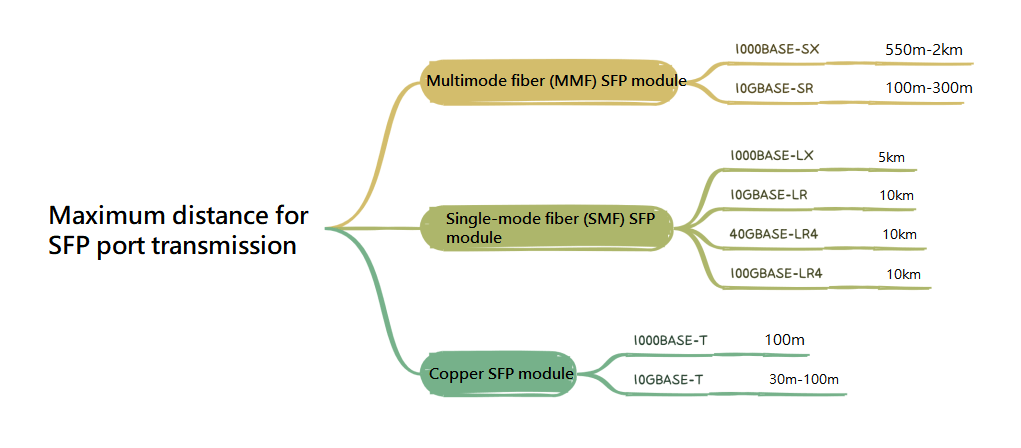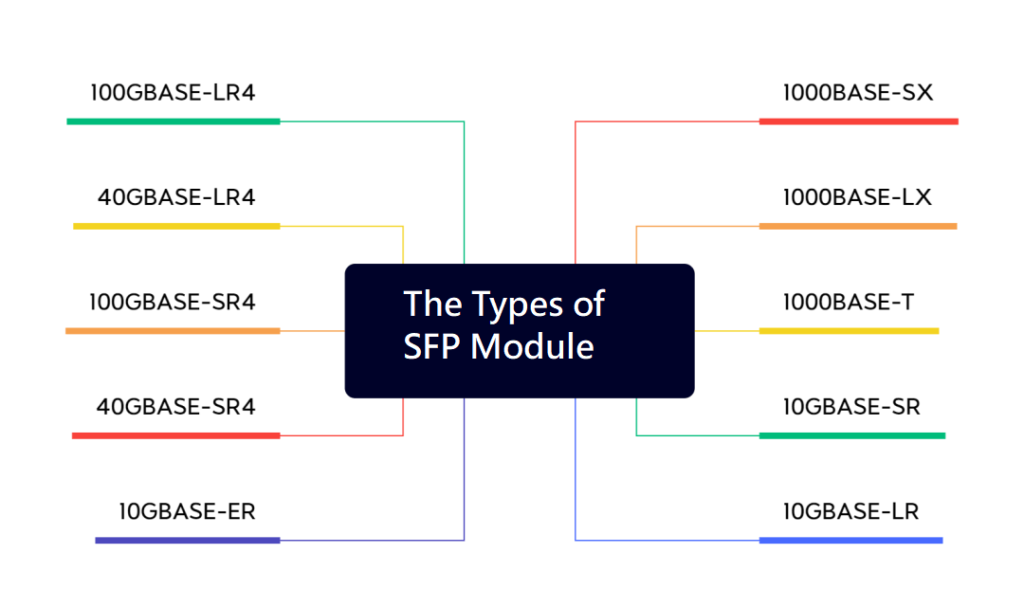

 Knowledge Base +
Knowledge Base +  2024.01.16
2024.01.16SFP (SmallFormPluggable) can be simple to understand for the GBIC (the abbreviation of GigabitInterfaceConverter) upgraded version, is a one billion - bit electrical signals into optical signal interface device, can use hot plug. GBIC is an interchangeable product that meets international standards. Gigabit switches with GBIC interface design occupy a large market share in the market due to their flexibility in interchangeability.
The SFP optical module was first introduced in 2001 and caused a major change in the networking field. The introduction of the SFP optical module to replace the previous GBIC (Gigabit Interface Converter) module is largely due to the small size and greater flexibility of the SFP optical module, making it one of the most important components in modern networks. SFP is a hot-swappable module used to transfer data between switches and other network devices.
Figure:1.25G SFP BIDI
The SFP interface is a standardized interface that allows users to replace network modules without shutting down the device. It is compact in design, easy to install and replace, and is a standardized solution for connecting gigabit Ethernet switches and other networking devices. The main purpose of the SFP interface is to provide flexibility, allowing the network administrator to select different types of SFP optical modules according to the needs of the network to achieve different transmission media and rates.
>>> To learn more SFP Optical Module Wiki
SFP can support many types of transmission media, including optical fiber, copper, etc., and different data transmission rates. The working principle of the SFP interface involves photoelectric technology. Here is a brief description of the workflow:
Physical connection: Gently insert the SFP optical module into the SFP port on the network device. The SFP interface is designed to be standardized to ensure that the module can be properly plugged in and physically connected to the device.
Power supply: After the SFP optical module is inserted, the device provides power for the module. The electronic devices and optical devices in the SFP optical module can work normally.
Data transmission: The working principle of the SFP optical module depends on its type, that is, whether it is an optical fiber or copper cable.
>>> To learn more What is a QSFP DD
Optical fiber connection: In an optical fiber connection, the SFP optical module includes an optical transmitter and an optical receiver. Data is converted from electrical signals in network devices to optical signals and transmitted through optical fibers. The sending end of the SFP optical module uses an optical transmitter to convert the electrical signal into a laser optical signal, and then sends it through the optical fiber. The receiving end of the SFP optical module uses an optical receiver to convert optical signals back to electrical signals for processing by network devices.
Copper cable connection: In a copper cable connection, the SFP optical module uses electrical signals for data transmission. Data is sent out by the electrical signal in the network device through the electrical interface of the SFP optical module, and is transmitted through the connected copper cable. This connection is suitable for short distance data transmission, such as connecting devices within the same rack.
Data processing: Whether it is an optical fiber or copper cable connection, the SFP optical module may also perform some data processing functions during data transmission, such as error detection and flow control, to ensure the accuracy and reliability of data.
Hot-swappable: An important feature of the SFP port is the hot-swappable feature, which means that the SFP optical module can be replaced or added without shutting down the device. This feature is very convenient for network maintenance and upgrades, and can reduce downtime.
The maximum transmission distance between two devices that an SFP interface can accommodate depends on a number of factors, including the type of SFP optical module used, the transmission medium (fiber or copper), the strength of the optical signal, and the network topology. Different types of SFP optical modules support different transmission distance ranges.
Here are some common SFP optical module types and their typical maximum transmission distances:

SFP Multi-mode Optical Fiber module:
1000BASE-SX: The maximum transmission distance is approximately 550 m to 2 km, depending on the fiber type and quality.
10GBASE-SR: The maximum transmission distance is usually in the range of 100 meters to 300 meters, also depending on the fiber quality.
SFP Single-mode Fiber Optical module:
1000BASE-LX: The maximum transmission range is usually less than 5 km.
10GBASE-LR: The maximum transmission distance is usually less than 10 km.
40GBASE-LR4 and 100GBASE-LR4: Maximum transmission distance up to 10 km.
Copper SFP module:
1000BASE-T: The maximum transmission distance is usually 100 meters.
10GBASE-T: The maximum transmission distance is usually 30 meters to 100 meters, depending on the quality and specification of the copper cable.
According to the transmission medium, transmission rate, and application scenarios, SFP optical modules can be divided into various types. The following are some common SFP optical module types:

1000BASE-SX: This SFP multimode optical module is suitable for short distance data transmission, usually in the range of 550 meters to 2 kilometers, it uses the optical wavelength of 850nm, suitable for short fiber distance environments.
1000BASE-LX: This is an SFP single-mode fiber optical module suitable for longer distance data transmission, usually within 5 km, it uses a light wavelength of 1310nm, suitable for longer fiber distance environments.
1000BASE-T: This is a copper SFP optical module that supports data transmission over copper cables of Cat5e or higher specification, typically over a maximum distance of 100 meters, suitable for short-distance connection needs.
10GBASE-SR: This multimode fiber-optic SFP optical module is suitable for high-speed data transmission over short distances, typically in the range of 100 to 300 meters. It uses a light wavelength of 850nm.
10GBASE-LR: This is an SFP single-mode fiber optic module suitable for high-speed data transmission over long distances, typically within 10 km, which uses a light wavelength of 1310nm.
10GBASE-ER: This is a longer-range SFP single-mode fiber optical module that can support transmission distances of up to 40 kilometers.
40GBASE-SR4 and 100GBASE-SR4: These SFP multimode fiber optic modules support 40Gbps and 100Gbps high-speed data transmission and are typically suitable for short-range connections, such as inside data centers.
40GBASE-LR4 and 100GBASE-LR4: These SFP single-mode fiber optic modules support 40Gbps and 100Gbps high-speed data transmission and are suitable for long distance connections, typically transmitting distances of up to 10 km.
In addition to the common types mentioned above, there are many other types of SFP optical modules, each optimized for specific transmission needs and application scenarios.
Small size and high density: SFP optical modules are half the size of GBIC, which allows them to be used in tighter and denser Spaces. In modern data centers and networking equipment, rack space utilization is critical, so the small size of the SFP optical module allows the device to accommodate more ports, thereby increasing network connection density.
Hot-swap: The hot-swap feature of the SFP optical module allows network administrators to replace or add modules while the device is running without shutting down the device. This significantly reduces downtime during maintenance and upgrades and improves network availability.
Flexibility: SFP optical modules can support many types of transmission media, including fiber and copper cables, and different transmission rates. This flexibility allows the network administrator to choose the right module according to the network needs to meet the requirements of different connections.
Long distance transmission: SFP optical modules support a variety of transmission distances, from short distances to long distances, and even up to tens of kilometers. This makes them useful for building wide area network connections and long-distance transmissions.
Subscribe to the newsletter
for all the latest updates.
2-5# Building, Tongfuyu Industrial Zone, Aiqun Road, Shiyan Street, Baoan District, Shenzhen. China
